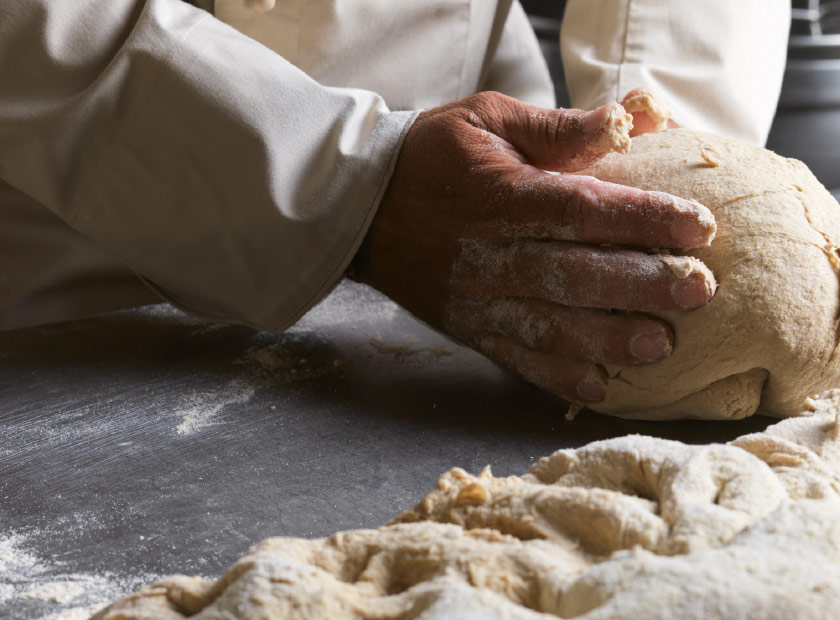
The history of bread is a ‘soft’ weaving of myth, religion and survival instinct.
Traces of it have been found dating back well before the Neolithic era. It seems that, basically, it was a method to ensure long-shelf-life and easily-transportable food. Undoubtedly, much water, and sourdough, have passed under the bridge since "bread" was made out of a mixture of water and broken, hulled, ground and sifted cereals (barley seeds and wild wheat).
We know well that water, oven engineering and scores of stories have ‘passed’. Already sacred to Demeter, the Mother Earth, and Ceres, it owes its name to Pan, who would have been the first to cook it, as legend has it. We find it in all cultures, cults and at any latitude, different in time and space, but always imbued with the history of nourishment, sacredness, and reciprocity. Just think of votive bread – that of All Saints' Day in Scicli, St. Joseph, St. Anthony, the Immaculate, the Eucharist, and the tradition of unleavened bread.
Bread has ruled the history of humanity. The reason is that it is complex food made out of competence, knowledge and farsightedness. It is not found in nature but depends on the human ability to master nature, from choosing the suitable wheat to grinding and diverse cooking methods. Its nutritional capacity has always made it a real cult and community object: the oldest tradition forbids cutting bread with a knife and entrusts the breadwinner with the task of breaking and distributing it.
A mixture of tradition and superstition forbids throwing it or putting it upside down. It also prescribes to kiss the bread when it falls to the ground and make the sign of the cross before kneading it – to make it only with a crescent moon. Otherwise, you will have a bread-making failure. In short, in times of pandemic, gluten intolerances, and tireless battles against carbohydrates, it seems impossible that tragedies and social revolutions have happened, and ambitions have worn off around bread. And yet, it is in everyday language: ‘as good as bread’, ‘someone’s bread and butter‘, ‘to live on bread and water’, ‘break bread with someone’, ‘bread is the staff of life’. In Palermo, fresh bread is a fragrance that wafts from the ovens all through the early morning streets, mixing with the taste of coffee, perhaps gulped down just before leaving home.
Bread is the produce of the land and the way the man encountered it. We choose it carefully because it is daily.
Bread must be perfect rather than good. The secret? According to Ottavio Guccione, "Time, temperature, technique, and passion indeed: every dough is different, but they all depend on the time you will give them. Here is the secret: start at 2.30 a.m. with the dough prepared the day before. And then, flours. I’ve got a mill for each type of flour. Whole-wheat flour requires a millstone and its fermentation process is different. And different is the temperature of the warehouse because if you get it wrong, you’ll have a bread-making failure! Then, the strange mystery of ovens. The wood-fired oven is more complicated. Despite not having a thermostat, it is more reliable, like many things of the past, because it runs on wood. It does not depend on the electrical energy – and what if all the lights go out? Should I leave people without bread? – I definitely shouldn’t. Actually, we can do without anything but the bread!" According to Ottavio Guccione, bread making has become his second life, transforming him from a young and promising athlete into an award-winning baker. Bread making must have strange alchemy as it calls people over. Even
Rocco Tanzarella says that bread was a rebirth for him: a successful freelance photographer, who also worked for Vogue, and a tireless traveller. One day, he decided to quit his job to make bread.
His idea? To bring the bread of Altamura to London. "They told me: it breaks teeth, no one will want it. And yet, it was my dream. So, I decided to learn. I called an elderly baker from Puglia, Antonio Vitale, and I’m still studying. Bread is a game where everything has to be balanced: the air, the water, the flour, the hands, and the temperature. And then, there’s the time: the more time you give it, the better. Here, we bake bread twice. You bake it, take it out of the oven and put it on the carts to sit for 12 hours. Then, you bake it and let it sit once again: this is how the crust caramelises. It will seal and keep the crumb protected, so its shelf life will be seven or more days. The crust may be very crispy, but once you break it, the heart will be soft and tasty. What matters is the raw material: wheat and flour. Whole-wheat flours don’t get mouldy since they contain few starches. Ancient-grain flours have none and must be kneaded differently. Then, there’s the sourdough, which is a living thing. For this reason, it may be affected by everything surrounding it, including the cold and the heat. It has its own chemistry, and if you don’t know it or study it thoroughly, you cannot make bread. So, I study bread making and learn from it. It‘s a continuous lesson of care and life: dedication, dedication, and dedication. I spend twelve to fourteen hours a day in the bakery, yet it isn’t a burden because I do it with love. I often start over a hundred times, learn and experiment, but it isn’t a burden because bread making is like a love story. When you get tired, it’s over. But if you don’t feel burdened, if you are curious, then it’s forever."






